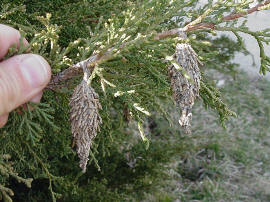|
 Column Column
Bagworms, Pruning Evergreens, and
Pumpkins
By John Fulton
 Send a link to a friend
Send a link to a friend
[June 15, 2015]
Bagworms - Bagworms are an
insect that conjures up images for many people. There are bagworms,
and there are other larvae that live in a bag for at least part of
their life cycle. We have bagworms, Eastern Tent Caterpillar, and
Fall Webworms.
|
|
 For the true “bagworm,” the insect that constructs a small bag
like an ice cream cone from the leaf material of the tree or
shrub it is on, the year-in and year-out treatment time for
bagworms is June 15. You can mark this date on your calendar for
next year and be within a few days of the correct treatment
time. With a very cool spring, a week later may be a possibility
This season’s yo-yo temperatures really even out. The idea is to
have all the eggs hatched before treatment. For the true “bagworm,” the insect that constructs a small bag
like an ice cream cone from the leaf material of the tree or
shrub it is on, the year-in and year-out treatment time for
bagworms is June 15. You can mark this date on your calendar for
next year and be within a few days of the correct treatment
time. With a very cool spring, a week later may be a possibility
This season’s yo-yo temperatures really even out. The idea is to
have all the eggs hatched before treatment.
The next problem is what to use. The traditional standby has
been Sevin, but the B.t. products such as Dipel and Thuricide
have really taken the majority of the market. Many other
products will work, but the B.t. products have several good
points including safety to mammals and toxicity to larger
bagworms. Since they are bacteria that affect only the larvae of
moths and butterflies, it does take a while for the bacteria to
build up to the point where they can kill the bagworm. I won’t
get into the discussion about Monarch butterflies lighting in
the tree just after treatment. And an item to note: there are
several different strains of B.t. now on the market. One is for
control of mosquito larvae, so make sure you get the correct one
by reading on the label what insects will be controlled.

If you are in doubt about whether you have bagworms, check your
trees and shrubs around June 15. You can actually see the small
bags as the larvae build them. They become very noticeable at
about 1/16 of an inch long. Treat bagworms early, since larger
ones are more difficult to control, but try to ensure the eggs
are all hatched out.
Most people think that bagworms only affect evergreens.
Evergreens seem to be their preferred host group, but bagworms
have a huge number of potential hosts. Through the years I have
seen them on oak trees, grape vines, apples, and about any other
growing thing you can think of.
Pruning Evergreens
This is the time of year, the last half of June, to prune
evergreens. This includes both needle-type and broadleaf
evergreens. If you’re wondering what a broadleaf evergreen is,
that includes holly, rhododendron, and azalea. The logic behind
pruning your evergreens at this time is to allow sufficient time
for regrowth to become hardened off before winter, and to keep
new growth from becoming too rank before the winter months.
[to top of second column] |

Pruning evergreens is part art and part science, but mostly art. A
few simple rules to follow make the job results much more
pleasing. Upright growing evergreens, such as pines and spruces,
should not have the main leader cut off. This will destroy the
natural shape, and will make the resulting growth more
susceptible to breaking off. If individual branches are being
cut off, they should be cut back to a bud. This will allow the
bud to become the new main branch. You can also control growth
direction of branches in this way. If you are growing trees for
cut Christmas trees, all bets are off, as you are only dealing
with trees through the first seven years of their life or so.
Make sure you use the proper equipment. Individual pruning cuts
are best done with bypass loppers or pruning shears. These make
clean cuts without much damage to the remaining wood. The old
anvil type shears and loppers cut to a point, then crush the
remaining wood. For yews, junipers, and arborvitae that are
trained to a certain size of shape, you will want to use hedge
shears (electric or manual) that are sharp and properly
tightened. Most of these types of shears can cut up to about a
quarter of an inch in size.
When pruning evergreens, remember the “dead zone.” This is the
area toward the center of the plant that doesn’t receive much
light. It also has few needles or active buds. Cutting into the
dead zone will cause many years (or forever) of little green
growth. Also remember to prune so that the base of plants is
wider that the top. This allows sunlight to hit the bottom area
as well, and keeps plants from browning from the bottom up.
Pumpkins
The primary use of pumpkins grown at home is for the Halloween
symbols that we have come to know. The correct time to seed
pumpkins for use at the end of October is around June 15, or
Father’s Day. Earlier seeded pumpkins tend to mature earlier and
are rotten by the time you want to display them. Make sure you
keep plants, especially new runners, treated for vine borers.
Beetles that can transmit wilt virus also must be prevented with
sprays or dusts.
[By JOHN FULTON, COUNTY EXTENSION
DIRECTOR SERVING LOGAN, MENARD, AND SANGAMON COUNTIES] |